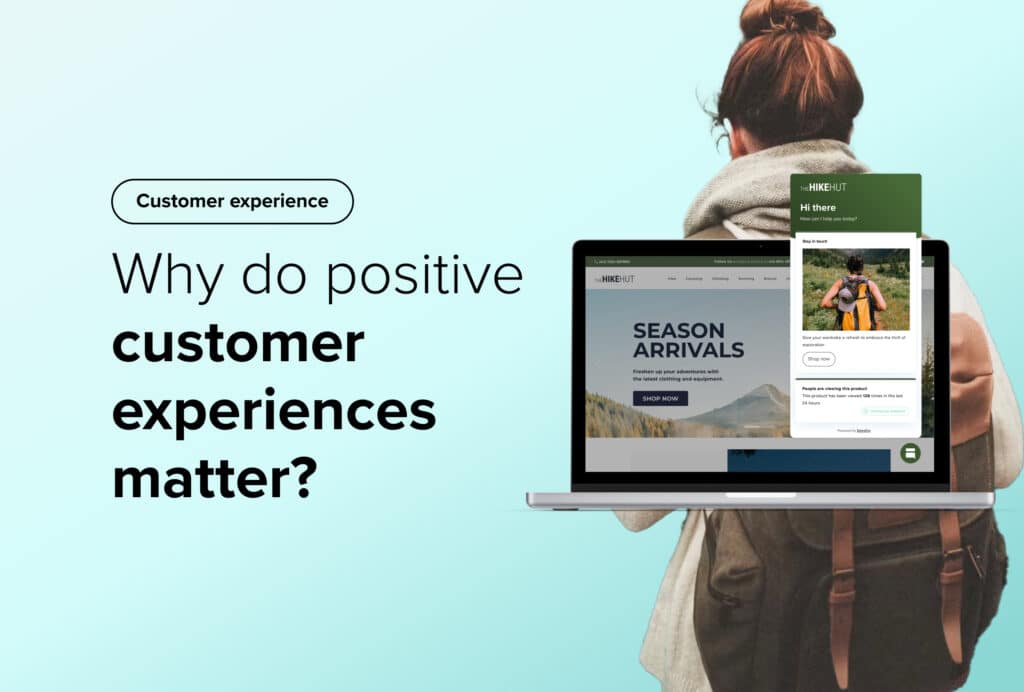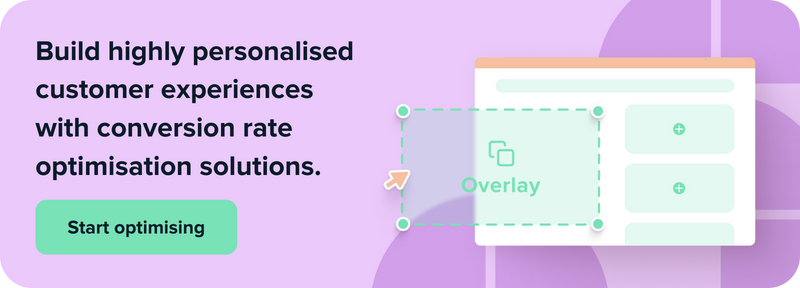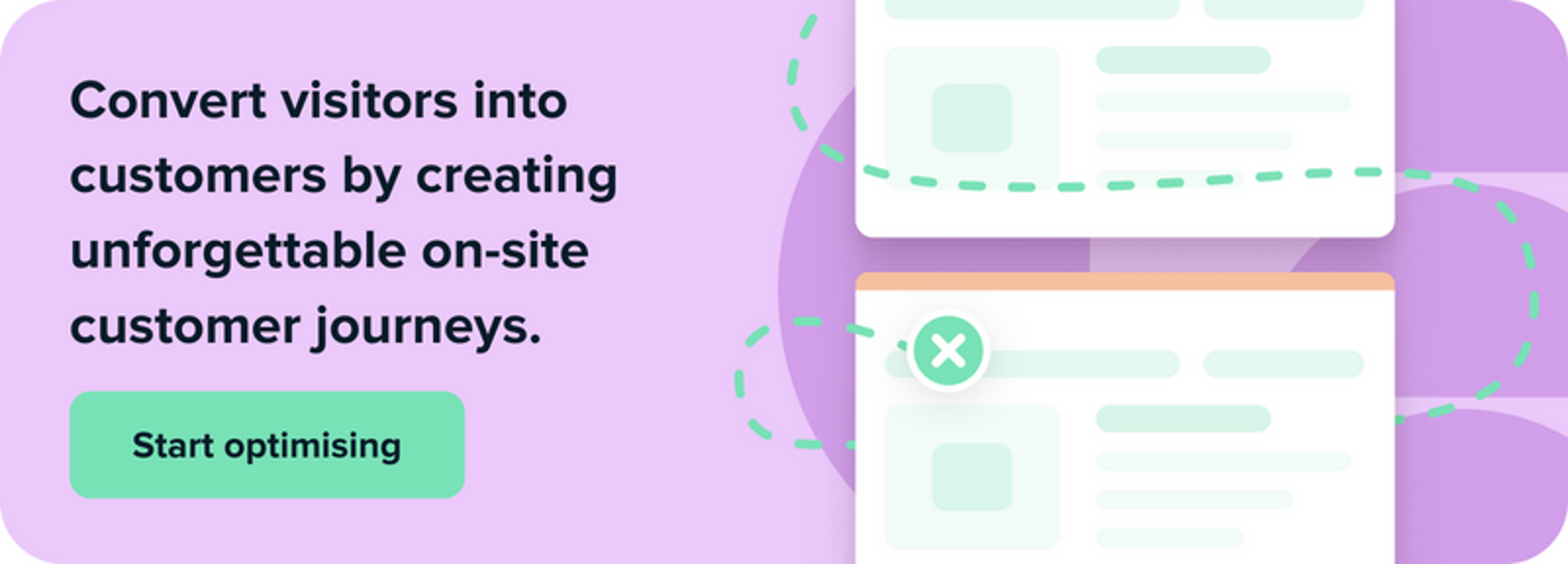What Is eCommerce Customer Experience and Why Is It Important?
By Bethany Llewellyn • Last updated: Wednesday Aug 14th, 2024

With thousands of eCommerce sites available in just a few clicks, it’s vital that eCommerce businesses provide excellent service throughout the whole customer journey to engage users and drive purchases.
In the end, a customer’s overall experience with a brand can be the difference between a conversion or a lost sale.
Read on to discover the importance of customer experience in eCommerce and how it can help improve customer loyalty, brand reputation and customer satisfaction.
What is the eCommerce customer experience?
The customer experience (CX) is a customer’s perception of their experience before, during and after their purchase.
Online shopping has become more than a transactional activity for consumers, it’s about being engaged and entertained.
Often, one of the most effective ways to approach customer experience in your business is to look at it through your own eyes as a consumer.
Identifying areas that made you feel satisfied or certain pain points that could use improvement will allow you to reflect on your current customer’s experience.
Regardless of your industry, providing the best eCommerce customer experience will drive sales and improve customer retention to grow your business.
Utilising personalisation to improve customer journeys
Now more than ever, consumers are growing increasingly sceptical of marketing.
With increased internet usage, customers are seeing hundreds of ads everywhere they turn, including from your competitors.
The human brain is unable to process all of these different messages, let alone respond to them – but personalisation cuts through the noise.
Personalised content directly addresses the viewer, meaning they are more likely to engage with it and click through to your site.
Continuing this content personalisation into your on-site messaging and promotions leads to:
- Improved customer journeys
- Increased average order value
- Converts shoppers into returning customers
In fact, 60% of consumers stated they would become repeat customers when offered a personalised experience.1
Not only does this improve conversion rates, but analysing the users who interact with your advertisements allows you to identify your target audience to market more effectively with the highest return on investment.
Suggested reading: Take the guesswork away and gain a deeper understanding of the importance of providing optimised user journeys in our blog, ‘6 Ways to Use Automation to Create an Intelligent Customer Experience’.
Benefits of providing a great customer experience
1. Increase conversions
Online customers are always on the lookout for businesses that provide a great customer experience and leave them feeling satisfied.
Whether a user lands on your site with a strong intent to purchase, or they’re still in the discovery stage, a personalised customer experience will quickly guide them through the buyer’s journey and towards your checkout page.
Here are some ways you can remove friction for your customers:
- Provide responsive customer support: Having a dedicated customer support presence, whether through a live chat, social media or FAQ page, will ensure you’re able to respond to customer queries promptly. Providing the information they’re looking for quickly will reduce basket abandonment by preventing users from leaving your site due to wait times or uncertainty.
- Display relevant and useful on-site messaging: Targeting the right customer with the right message is one of the most effective ways to optimise your campaigns. Automating campaigns through on-site tools like Digital Assistant allows you to surface tailored messaging at key moments throughout the buyer journey.
- Deliver personalised recommendations: With AI-powered tools like Recommendations, you can analyse consumers buying behaviour to anticipate their wants and needs. This helps connect shoppers to their perfect purchase quicker whilst providing an excellent customer experience.
eCommerce personalisation is crucial to engage shoppers and remove friction from the buying journey.
What you can do: To capitalise on existing website traffic, a fully mobile-optimised homepage with easy navigation encourages shoppers to browse your site and provides a clear path throughout the customer journey, creating a seamless experience for customers and ultimately increasing conversions.

2. Improve customer retention rates
The cost of acquiring a new customer is significantly more expensive which makes retaining your current customers all the more important.
Research shows that the probability of selling to an existing customer is around 60-70% when compared to a new prospect which is 5-20%. This means increasing your customer retention rate by 5% will increase profits from anywhere between 25% to 95%.2
If you provide a customer experience that sets you apart from the competition, you can:
- Create a surge in conversion rates
- See customer retention rates rise rapidly
- Create an emotional connection with users
Providing the best eCommerce customer experience creates emotional connections, builds trust and anticipates needs – all of which are core elements for customer retention.
3. Enhance brand reputation
Providing a seamless experience in eCommerce can strengthen your brand reputation vastly through word-of-mouth marketing or user-generated content.
Due to social media, consumers get exposed to new brands day-in-day-out, making it harder for your business to stand out from the crowd.
The better the experience, the more your customers will promote your brand to their friends, family or on their social media, giving you a perfect source of user-generated content.
With word-of-mouth marketing being one of the most persuasive forms of recommendations, delivering an experience that delights customers and gains you brand ambassadors will create a stream of new customers who are already well on their way to being bought into your business.
Suggested reading: Positive customer experiences and repeat customers have a direct correlation. Find out how your brand personality can improve your customer retention rates in our article, ‘The Importance of Brand Identity to Encourage Repeat Customers’.
4. Reduce complaints
Customer service is a core part of a user’s experience.
In addition to being negative for your business, customer complaints require time to process, investigate and for your staff to handle.
It can be an overall tedious and unpleasant task for both the customer and your employees to deal with.
But, providing exceptional customer service creates an overall positive experience that reduces the number of complaints you may receive.
Being available across all channels your customers may shop on is the first step in providing a high-quality level of service.
Advice on next steps: It’s not just during the customer journey, the post-purchase experience is vital in delivering the experience your customers deserve.
Having clear communication when answering product questions, or updates on delivery status or returns process is the key to reducing complaints and securing repeat business from happy customers.
Best practices for an enhanced customer experience
The goal for any retailer, in both online and brick-and-mortar stores, is to provide memorable customer experiences.
Statistics show 77% of companies believe customer experience is a key competitor differentiator.3
Since good CX boosts customer loyalty, satisfaction and conversion rates, it’s an essential ingredient for eCommerce success.
Here are some best practices we think should be at the centre of any customer experience strategy.
1. Optimise the on-site user experience
Slow load times, poor navigation and sites that aren’t optimised for mobile are just a few of the things that can affect a customer’s experience when they shop with you.
All of these help lead a user through the customer journey and if done incorrectly can have a negative impact on both your conversion rate and your visitor’s experience on-site.
Empower your customers to shop the way they want to and open your business to a whole new range of mobile shoppers by having a mobile-first approach.
There are over one billion smartphone users who shop online via their mobile, so don’t deter these users with a site that is poorly designed for mobile.
Optimising your site for mCommerce comes with various benefits:
- Improved customer experiences: Mobile shoppers want a quick and easy experience on your website. Having a search bar that returns accurate results instantly is the key to keeping these shoppers engaged and satisfied.
- Increased product discovery: Social media and mobile commerce go hand in hand. Since many smartphone users shop for products on social media, creating a seamless and cohesive experience through your optimised mobile site will allow your shoppers to browse for products effortlessly
- Better data and analytics: Smartphone software can easily be connected to customers’ data, including location, buying history and email addresses. Utilising this data will allow you to create better, personalised experiences for each mobile shopper who visits your store.
- Greater engagement with customers: Push notifications on mobile is a great way to encourage users to return to your app or site to complete a purchase whilst building strong customer relationships through consistent communication.
Mobile commerce will continue to expand so it’s key to optimise your online shop, app and overall online shopping experience for your shoppers.
Suggested reading: Explore the benefits of mobile commerce along with tips on how you can optimise the mCommerce experience in our blog, ‘6 Benefits of mCommerce’.

2. Guide customers through the buyer’s journey
Surfacing the right message or incentive to the right people at the right time is the key to a truly tailored and memorable customer experience.
Customers expect a tailored on-site experience. Statistics show that 42% of users become annoyed by content that isn’t personalised to them and that 50% of users are willing to share their data in order to receive a personalised experience.4
Being able to subtly suggest genuinely relevant products throughout a shopper’s journey without disrupting the browsing experience will improve the eCommerce customer experience.
Tools like Salesfire’s Digital Assistant which can display and store campaigns will allow you to strategically suggest products or show messages at the most influential moment in the buying process.
This targeted messaging technique allows you to assist shoppers in finding their perfect product, guide users through the sales funnel and ultimately increase your conversion rate.
3. Provide a consistent and cohesive experience
Keeping it consistent and cohesive across all of your platforms ensures each customer receives the same experience with your brand, no matter where they find you from.
Whether they interact with your brand through your site, social media, video content or emails, providing an omnichannel experience allows customers to browse without any issues.
This omnichannel marketing strategy will ensure that every touchpoint is a consistent and unified experience that will:
- Drive traffic and sales to your eCommerce site
- Provide a seamless shopping experience
- Increase brand awareness
- Improve customer loyalty
Over time, your customers will begin to recognise your brand and increase the likelihood of them becoming advocates.
4. Get to know your customers through data
What consumers truly want is for the eCommerce brands they shop with to listen to their wants and needs.
With data, you can.
Whether this is through a survey or by analysing the data on your site, you can use the stats to reflect on where you can improve your eCommerce site for the better.
For example, if you find your basket abandonment rate is high, or that customers bounce at the last moment before making a purchase, you may need to offer a faster experience like a guest checkout option to optimise the checkout process.
From here, you can review eCommerce customer experience trends to try various strategies or campaigns on your site to see which your audience loves.
Data is an important factor for many online stores that can help you:
- Create personalised customer journeys: Using customer data, you can suggest relevant items on product pages based on what users with similar shopping journeys viewed. This can ensure you’re providing a tailored experience and increase the likelihood of conversions.
- Improve customer loyalty: Shoppers who are made to feel unique and have a great shopping experience on your website will want to return to your site time and again for the same feeling.
- Create reactive marketing campaigns: Monitoring and analysing customer data analytics will allow you to identify trends and patterns to create responsive and reactive marketing campaigns.
Ultimately, your customers will be left with a data-focused experience, increasing satisfaction and improving conversion rates.
Suggested reading: Find out the importance of improving customer experiences using data analytics in our blog, ‘How Utilising Trends and Data Can Strengthen the Customer Experience’.
Final thoughts
Providing the best customer experience in eCommerce should be every business’s goal.
Understanding the importance of providing a great experience can help you to increase conversions, improve your brand recognition and create strong connections with customers who genuinely care about your business.
Even with the eCommerce space constantly evolving, there is no doubt that the great experience a customer expects will remain high.
Utilise the best practices we’ve identified to take your business to the next level.

1 The State of Personalisation 2021 Report | Twilio
2 Customer Acquisition vs Retention Costs | Invesp
3 Top 40 Customer Experience Statistics You Need to Know in 2023 | Emplifi
See how Salesfire can help you optimise your product discovery experience, email one of our experts at [email protected] or book a free demo of our personalisation tools.



